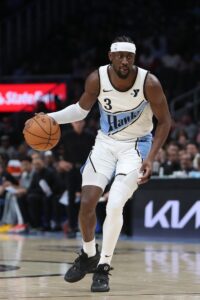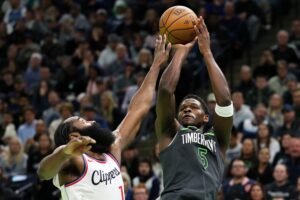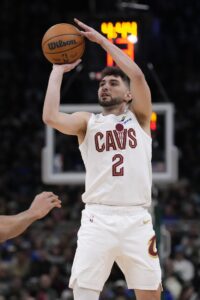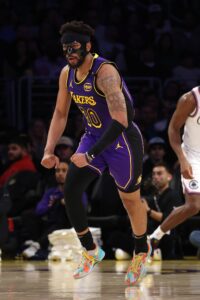The Bird exception, named after Larry Bird, is a rule included in the NBA’s Collective Bargaining Agreement that allows teams to go over the salary cap to re-sign their own players. A player who qualifies for the Bird exception, formally referred to as a Qualifying Veteran Free Agent, is said to have “Bird rights.”
The most basic way for a player to earn Bird rights is to play for the same team for at least three seasons, either on a long-term deal or on separate one- or two-year contracts. Still, there are other criteria. A player retains his Bird rights in the following scenarios:
1. He changes teams via trade.
 For instance, the Hawks will hold Caris LeVert‘s Bird rights when he reaches free agency this offseason, despite just acquiring him in February. His Bird clock didn’t reset when he was traded from Cleveland to Atlanta.
For instance, the Hawks will hold Caris LeVert‘s Bird rights when he reaches free agency this offseason, despite just acquiring him in February. His Bird clock didn’t reset when he was traded from Cleveland to Atlanta.
2. He finishes a third season with a team after having only signed for a partial season with the club in the first year.
The Cavaliers signed Sam Merrill during the second half of the 2022/23 season, adding him to their roster in March 2023. When his contract expires this offseason, Merrill will have Bird rights despite not spending three full seasons with Cleveland, because that partial season in ’22/23 started his Bird clock.
3. He signs a full-season contract (ie. not a 10-day deal), his team waives him, and he cleared waivers. He subsequently re-signs with the club (without joining another team in the interim) and ultimately remains under contract through a third season.
This one’s a little confusing, but let’s use former Lakers big man Christian Wood as an example. After spending the 2023/24 season with Los Angeles and opening the ’24/25 season on the roster, Wood was waived by the team in February.
If the Lakers were to re-sign Wood in July without him joining a new team in the interim, his Bird clock would pick up where it left off. He’d have full Bird rights in the summer of 2026, since he would’ve spent part or all of each of the previous three seasons with the Lakers without changing teams in between.
Although the Lakers could restart Wood’s Bird clock by re-signing him, they wouldn’t be able to use any form of Bird rights to add him to their roster this offseason — they would have to use cap room or another exception to do so. His Bird clock would only resume once he’s back under contract.
This rule also applies to players who are waived after they already have Bird rights. For example, let’s say the Heat were to waive Duncan Robinson this offseason before his $19.9MM salary for 2025/6 becomes guaranteed.
Miami, which doesn’t project to have cap room this summer, would have no means to re-sign Robinson except via the minimum salary exception or perhaps the mid-level exception, since waiving him would mean losing his Bird rights. But if they did find a way to re-add him on a one-year contract after waiving him, the Heat would regain Robinson’s full Bird rights in 2026.
A player sees the clock on his Bird rights reset to zero in the following scenarios:
- He changes teams via free agency.
- He is waived and is not claimed on waivers (except as in scenario No. 3 above).
- His rights are renounced by his team. However, as in scenario No. 3 above, a player’s Bird clock picks up where it left off if he re-signs with the club that renounced them without having signed with another NBA team. For example, Kelly Oubre had Non-Bird rights last offseason, then had those rights renounced by the Sixers as they freed up extra cap room. Since Oubre eventually signed a new deal with Philadelphia, his Bird clock picked up where it left off — if he picks up his 2025/26 player option, he would have full Bird rights during the 2026 offseason.
- He is selected in an expansion draft.
Players on two-way contracts accumulate Bird rights in the same way that players on standard contracts do. Jazz center Micah Potter has been under contract with Orlando on two-way deals in each of the past three seasons, so if he remains on his current two-way deal through the end of 2024/25, he’ll have full Bird rights this summer.
If a player who would have been in line for Bird rights at the end of the season is waived and claimed off waivers, he would retain only Early Bird rights.
It’s also worth noting that there’s one specific scenario in which a player with Bird rights can lose them in a trade. A player who re-signs with his previous team on a one-year contract (or a one-year deal with a second-year option) would have his Bird clock reset if he’s traded later that season. As such, he receives the ability to veto trades so he can avoid that scenario.
[RELATED: Players who had the ability to veto trades in 2024/25]
The Bird exception was designed to allow teams to keep their best players, even when those teams don’t have the cap room necessary to do so.
When a player earns Bird rights, he’s eligible to re-sign with his team for up to five years and for any price up to his maximum salary (with 8% annual raises) when he becomes a free agent, no matter how much cap space the team has — or doesn’t have.
The maximum salary varies from player to player depending on how long he has been in the league, but regardless of the precise amount, a team can exceed the salary cap to re-sign a player with Bird rights.
A team with a Bird free agent is assigned a “free agent amount” – also called a cap hold – worth either 190% of his previous salary (for a player with a salary below the league average) or 150% of his previous salary (for an above-average salary), up to the maximum salary amount.
For players coming off rookie scale contracts, the amounts of those cap holds are 300% and 250%, respectively. The Bulls, for instance, will have a cap hold worth $25,057,101 for Josh Giddey on their books this offseason — 300% of his $8,352,367 salary for 2024/25.
Chicago could renounce Giddey and generate an extra $25MM+ in cap flexibility, but doing so would cost the Bulls the ability to re-sign him using Bird rights, which would force them to use either cap room or a different cap exception to re-sign him. As such, we can probably count on Chicago keeping Giddey’s cap hold on the books until his free agency is resolved.
Note: This is a Hoops Rumors Glossary entry. Our glossary posts will explain specific rules relating to trades, free agency, or other aspects of the NBA’s Collective Bargaining Agreement. Larry Coon’s Salary Cap FAQ was used in the creation of this post.
Earlier versions of this post were published in previous years by Luke Adams and Chuck Myron.
 The Rockets have been playing excellent basketball over the past few weeks and have surged up to No. 2 in the West with a 48-26 record. Only a catastrophic collapse would prevent them from earning a top-six seed, as they hold a 5.5-game lead on the No. 7 Warriors with eight games remaining.
The Rockets have been playing excellent basketball over the past few weeks and have surged up to No. 2 in the West with a 48-26 record. Only a catastrophic collapse would prevent them from earning a top-six seed, as they hold a 5.5-game lead on the No. 7 Warriors with eight games remaining.
 For instance, the Hawks will hold
For instance, the Hawks will hold 